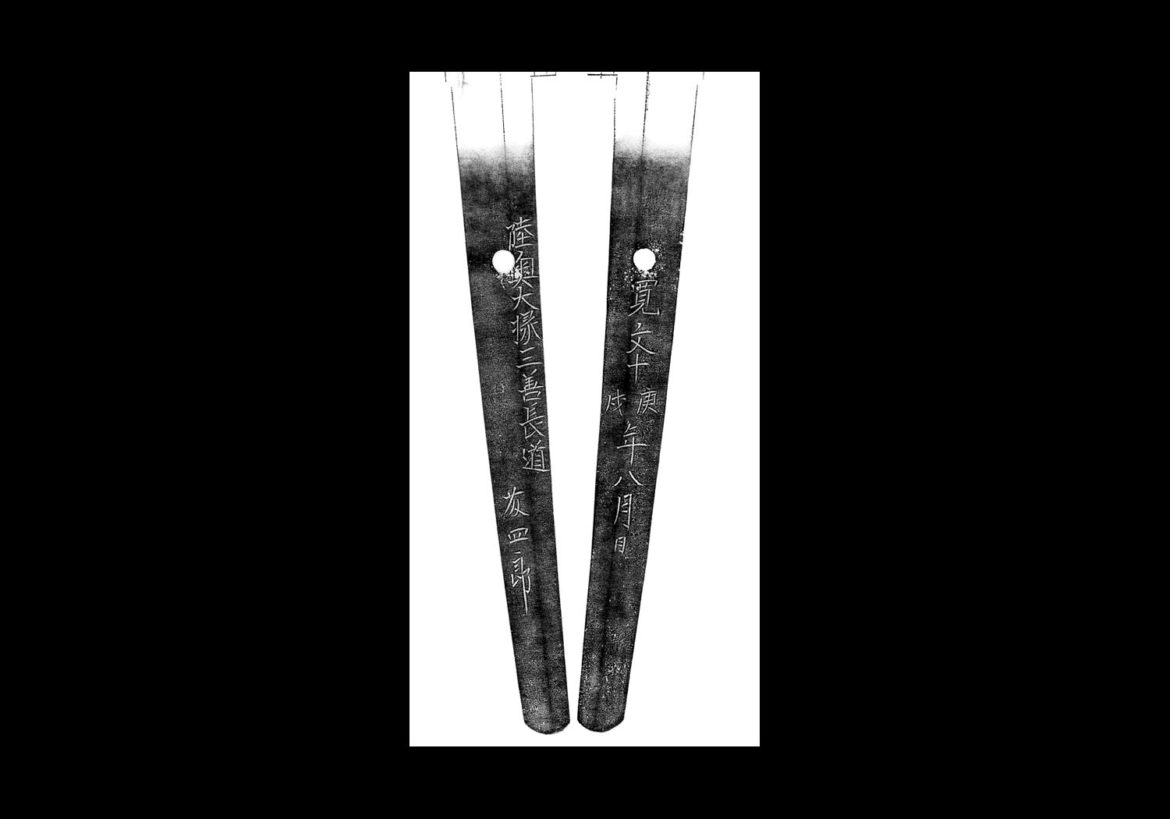
Aizu Nagamichi (会津長道) was born in 1633 in Ôshû of Aizu Province. He was the son of Masanaga (政長) and was called Tôshirô. He was the grandson of Nagakuni (長国) of Matsuyama of Iyo Province. His grandfather, Nagakuni (長国), and his father, Masanaga (政長), were retainers of the Daimyo Kato Yoshiaki. In 1627 they moved with Kato Yoshiaki to Ôshû in Aizu Province where in the tenth year of Kanei or 1633 Nagamichi (長道) was born. His father died when he was sixteen years old so he took his early apprenticeship with his uncle Nagatoshi (長俊). He wrote his initial mei as Michinaga (道長) but changed it to Nagamichi (長道) when he went to Kyoto in 1659 to receive the title Mutsu no Daijo (陸奥大掾).
It is believed that he either studied with Tsuda Sukehiro (津田助広) while he was in the Kyoto/Osaka area or that he studied with Kotetsu (虎徹) during this same period. Since his works so closely resemble those of Kotetsu (虎徹), it is more likely that he went to Kotetsu (虎徹) to perfect his skills. In fact he is commonly known as the Aizu Kotetsu (会津虎徹).
The works of Aizu Nagamichi (会津長道) were famous for their cutting ability. In two books, the Kai-Hôken-shaku (懐宝剣尺), the Yearned for Treasure Swords, and the Kokon-Kaji Bikô (古今鍛冶備考), Record of Ancient and Modern Smiths, the cutting ability of swords by certain sword smiths is ranked. Nagamichi (長道) is rated as Saijô-Ôwazamono. That is the highest rating for cutting ability thus making him famous for the sharpness of his blades. Nagamichi (道長) passed away in 1685 at the age of 53.
His lineage went on for seven or eight generations with a gradual decline in quality except for the sixth generation who did some fine work. Aside from the future generations of smiths by the name Nagamichi (長道), this school also produced other quality smiths. Three of these smiths were Nagatoshi (長俊), Michitoki (道辰), and Nagayoshi (長吉). Of these, Michitoki (道辰) was, by far, the best known and most skillful. His lineage went on for five generations.
The blade shown here is by the first generation Nagamichi (道長). It is dated as being made in 1670, the tenth year of Kanbun (寛文). It is signed Mutsu Daijô Miyoshi Nagamichi Tôshirô (陸奥大掾三善長道藤四郎).
The following are the general characteristics of the Aizu Nagamichi Kei (会津長道系):
SUGATA: With katana and wakizashi, shinogi-zukuri is the most common, but occasionally there is also a kiriba-zukuri or kanmuri otoshi zukuri. These unusual shapes are more common among the works of Nagakuni or Masanaga. Those having a shallow sori and ko-kissaki are the most common, but there are also some having a more robust sori and a chu-kissaki. There will be some narrowing toward the point.
JITETSU: Most often a very tight and beautiful ko-itame hada will be found. There are some that have a tinge of masame. The jigane will be clear but hard. Generally, there will be masame hada above the shinogi.
HAMON: The yakiba tends to be wide. Gunome-midare or o-gunome is the most common. Suguha and notare can also be found. Work is done in nioi deki with the nioi-guchi bright and clear. Nie will be found along the habuchi but they will not always be evenly distributed along the length of the hamon. Ashi, sunagashi, and kinsuji will be found. The hamon will usually start off with an Edo style yakidashi.
BÔSHI: A ko-maru bôshi is most common, but occasionally there is one with a hint of hakkake, a hint of midare, or one that returns very slightly toward the mune like yakizume.
NAKAGO: Kaku mune is the most common and there are also maru mune. As for the tip, there are kurijiri, katayamagata, and ha-agari kengata. The yasurimei is yoko (horizontal) or katte sagari.
MEI: Usually it is naga-mei, but depending on the smith, there is an occasional niji-mei.
MUTSU (no) DAIJÔ MIYOSHI NAGAMICHI 陸奥大掾三善長道
MUTSU (no) DAIJÔ MIYOSHI NAGAMICHI TÔSHIRÔ 陸奥大掾三善長道藤四郎
MUTSU AIZU JÛ NAGAMICHI 陸奥大掾住長道


